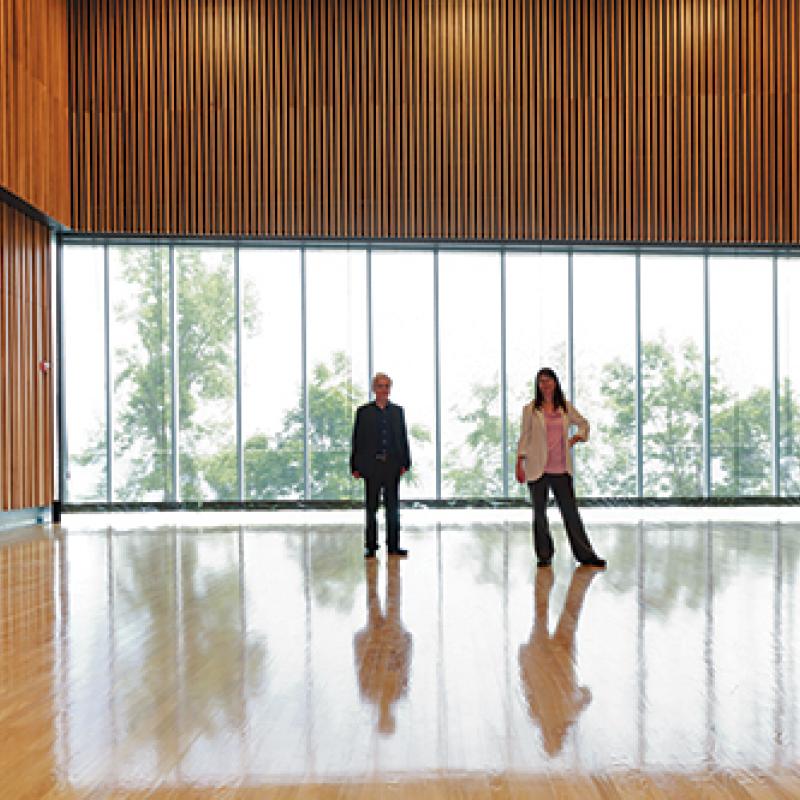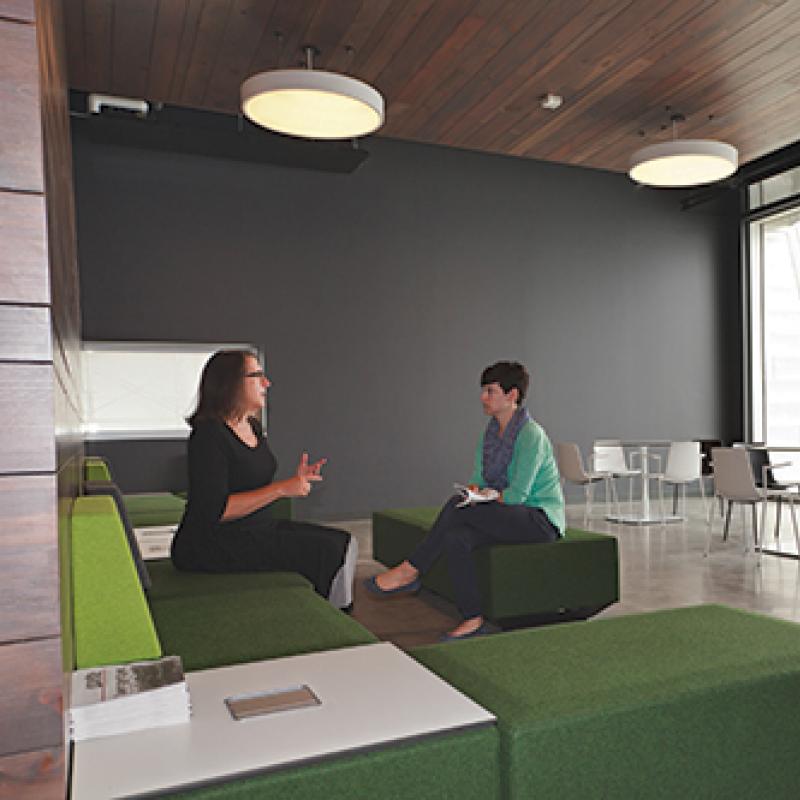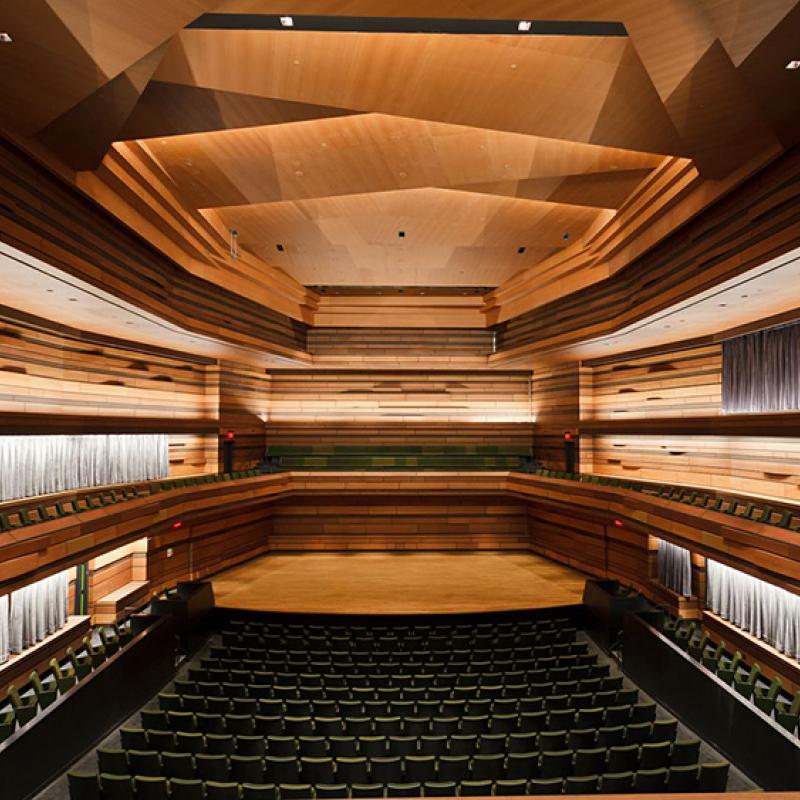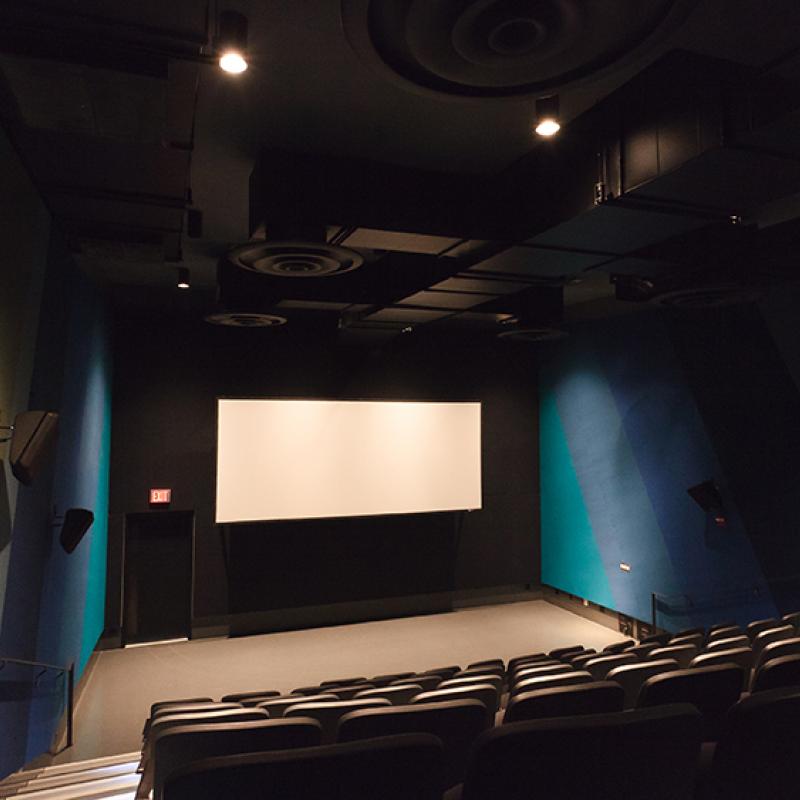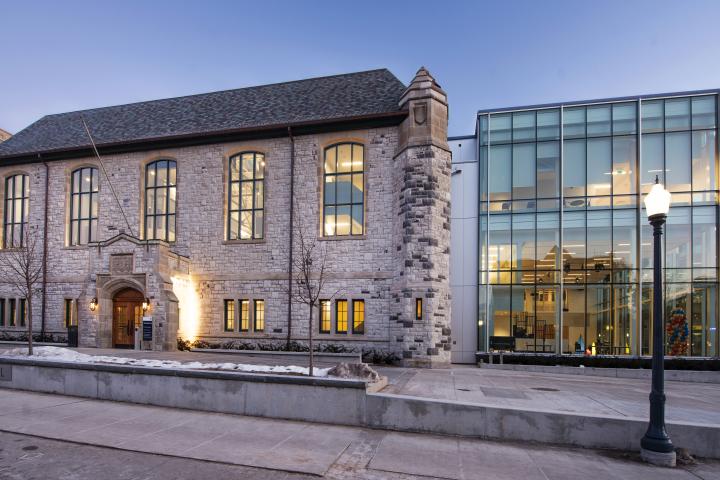Film major Charlotte Orzel, Artsci’15, remembers getting her first look at the Isabel Bader Centre for the Performing Arts – also known as the Isabel – back in April.
“The first time I walked in, it was pretty spectacular!” she says. “It’s so open, there is so much light, and the performance hall is amazing.”
She has good reason to be enthusiastic. When the Isabel formally opens in September, Ms. Orzel and her classmates will be among the first to call the 80,000 square foot facility home. The building was designed by world-renowned architectural firm Snøhetta (past projects include the Oslo Opera House and the National September 11 Memorial Museum Pavilion in New York) in collaboration with Ottawa’s N45 architects. Lead architect Craig Dykers wanted the building to establish a strong connection between the landscape and the character of the shore.
The Isabel houses the Department of Film and Media, and will provide learning and working spaces, as well as exhibition and performance spaces, for the School of Music, the Department of Drama and the Bachelor of Fine Art program. The building also boasts a flexible 100-seat studio theatre, a film screening room and a multipurpose rehearsal hall.
But it is the Isabel’s acoustically superior concert hall, a warm, wood-lined space with seating for 566 that is making Kingston the envy of music lovers across the country. Virtually a building within a building, the intimate hall is surrounded by two-foot thick concrete walls that muffle noise. Its curved wooden walls cut echo and improve the acoustics, while retractable, motorized acoustic drapes permit even more customizable sound. The acoustics, designed by New York-based Arup, were conceived using their Virtual SoundLab technology, which allows the environment of a space to be listened to before it is even built.
This building really is a game-changer for Queen’s and for Kingston. It is going to allow our students to learn in state-of-the-art facilities and will make Kingston a destination for international calibre artists.
The 2014-2015 inaugural season, which Mr. Doiron programmed, will feature performances by American violinist Sarah Chang, French pianist Cédric Tiberghien, and the Zukerman Chamber Players, among others.
For many on campus, watching the Isabel come to life on the Kingston waterfront has been a dream come true. “I remember first arriving at Queen’s in 1988 and hearing people talk about how it was too bad we didn’t have a dedicated recital hall,” says Gordon Smith, Vice-Dean, Faculty of Arts and Science, and former director of the School of Music. “Most music faculties have such a facility as part of their infrastructure.”
Dr. Smith, who soon found himself on a recital hall committee, remembers various discussions on where such a facility might be housed on campus. He says that while there were plans in the early 2000s to build a modest recital hall adjacent to Harrison-LeCaine Hall, the home of the School of Music, they were scrapped when it was decided an additional building would have been out of place in that location. “I remember feeling disappointed at the time,” he recalls, “but I agree with them now.
Not long afterwards, however, the university’s most generous benefactors, Alfred Bader (Sc’45, Arts’46, MSc’47, LLD’86) and his wife, Isabel (LLD’07) provided a lead gift for the project. In 2006, Principal Karen Hitchcock began negotiating with city officials for Queen’s to purchase two historic buildings – the Stella Buck building and a former stable building – as the site for the anticipated performing arts centre. The site also included the J.K. Tett Centre, which, together with the Stella Buck building, originally formed part of the Morton Brewery and Distillery complex, reputed to be the largest of its kind in North America in the mid-19th century.
In 2009, Principal Tom Williams announced that the university had secured the funding it needed to pursue the project. “I believe this performing arts centre will be an iconic addition to the already vibrant cultural centre that is Kingston,” he wrote in a release to the community, pointing to secured financial backing from the Governments of Canada and Ontario and the City of Kingston, in addition to the Baders’ gift, by now substantially more generous.
For faculty in the Department of Film and Media, the news about a potential hub for the university’s creative arts disciplines was received with both hope and just a little trepidation. “We were terrifically excited about the prospects for Film and Media curriculum and interdisciplinary adventures. But we were also sad to say goodbye to the Film House,” recalls Susan Lord, associate professor and current head of the Department of Film and Media. “It had been home to generations of film students who went on to become very important people on the Canadian cinema scene. Our students really inhabited the building like a house, and it was hard to consider leaving that.”
At the same time, it was clear the department was outgrowing the buildings at 154 and 160 Stuart Street that it had occupied for more than 40 years. Due to growth within the film production concentration, there was no longer enough working space for students, nor enough office space to accommodate additional adjunct faculty. The cramped quarters also meant students had to call on their creativity when producing their film and video projects, due to a lack of industry-standard production or sound studios. “In the past we had to be very artisanal in our approach,” says Dr. Lord, “though it yielded incredible creativity in fiction, documentary and experimental film and video.”
By contrast, the Isabel’s spacious facilities mean students will have plenty of room to spread their wings. “I think the new space will gear the future of the program,” says Natalea Robyn, Artsci’15, a gender studies major who is taking a minor in film, and who, together with Ms. Orzel, is also working at the Isabel over the summer as part of the Student Work Experience Program.
[The Isabel] will allow us to do more hands-on learning, which is something I know that a lot of film students want. We’ll have a sound stage and a light stage and a huge equipment room that can accommodate five times the amount of equipment we currently have. We will also have our own movie theatre, which is super cool!
Additionally, both Ms. Robyn and Ms. Orzel are excited about the increased potential for working with students in other disciplines now that they will be crossing paths more regularly in the shared space. “This facility will allow both students and faculty to deepen and formalize collaborations,” says Dr. Lord, explaining that short of a handful of interdisciplinary courses shared with the four creative arts units, and the Stage and Screen program, which enables students to take courses in film and drama, there currently isn’t a lot of mixing within the disciplines.
For Margaret Walker, Director, School of Music, the Isabel presents a wonderful opportunity for expanding and modernizing learning within the arts. “Music programs are constantly challenged to keep things current while preserving valuable traditions. Much of the music we play and study is over 100 years old,” she says, explaining that keeping in touch with the professional world of music making will be key to helping students succeed after they have graduated. “We want our students to be equipped to pursue careers in fields like arts management, audio-visual production, and even music theatre. The interdisciplinary nature of the Isabel will facilitate that.”
Dr. Smith agrees. “The Isabel far exceeds historical expectations in every respect,” he says. “The concert hall and other performance and learning spaces are spectacular, as is the fantastic location on the lake. With this new facility, we are closer than ever to realizing innovative synergies across the arts.”
In the Department of Film and Media, plans are already underway to revamp the fourth-year curriculum to make optimum use of the new facilities. Dr. Lord says the space will allow faculty to invite more visiting artists and industry experts to lead workshops and give guest lectures. Beginning in September, film majors will be free to choose a final project that aligns with their interests and the skills they want to develop – from creating a short fictional or experimental film to an installation piece, online magazine or traditional thesis. Based on the success of the interdisciplinary graduate program in cultural studies at Queen’s, Dr. Lord, with her colleagues across Arts and Science, hopes to grow a similarly themed undergraduate stream structured around experiential learning.
Mr. Doiron, who hopes to involve students in programming the building in order to ensure they have a strong sense of ownership, says he wants to prioritize having the Isabel’s visiting talent connect with the Queen’s community, whether that means leading master classes or doing casual Q&A sessions with students. “My biggest fear would be that the Isabel is seen as a pristine recital hall with no real connection to what Queen’s is ultimately about. I think it is a hope of Isabel and Alfred Bader’s that this building be full of life both day and night. It’s my job to make sure that they are not disappointed.”
Sitting at tables in the Isabel’s student film lounge, a bright space lined with reclaimed wood and soft benches readily designed for laptop use, Ms. Robyn and Ms. Orzel seem up for the challenge of becoming the first class of students to
call the Isabel their own.
“We have this giant, beautiful new building,” says Ms. Robyn, “so I feel like we should try and live up to the standard that’s been set for us.” As a couple in a canoe paddle by on the lake below, Ms. Orzel nods her head in agreement: “At the moment, the possibilities seem endless.”
Attention Film and Media alumni!
This October will be your chance to bid farewell to the Film House and to check out the Department of Film and Media’s brand new digs at the Isabel. The Queen’s Film Homecoming and Housewarming will be held October 17 – 19. The reunion will involve tours, parties, a banquet and a keynote address from recently retired professor Peter Baxter. For more information, email film@queensu.ca or call 613-533-2178.
